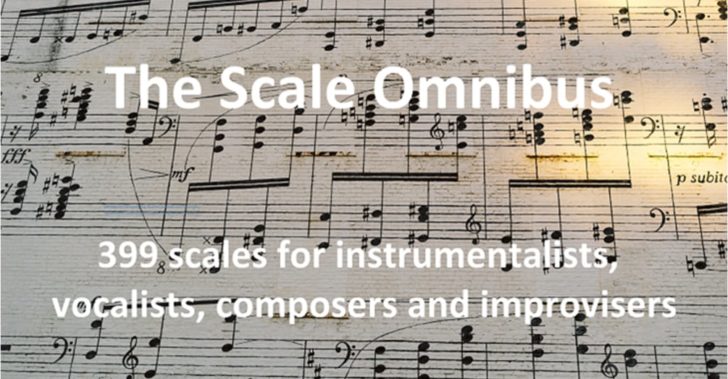Francesco Balena has published the 2nd edition of The Scale Omnibus, a free 450-page ebook that describes scales from all over the world.
The book covers scales for all music genres, with historical notes and trivia, featuring search by intervals or names (1000+ synonyms) and more.
“The Scale Omnibus is the most interesting book about scales I have read,” notes musician and educator Javier Girotto. “Over the years I had a look at many books on this topic, yet this omnibus is by far the most complete one and the one that goes deeper. I decided to go back to studying scales and their combinations with a fresh new approach, and used this book as a motivation for new roads in improvisation and, above all, composition.”
Pricing and Availability
The Scale Omnibus is available now on a pay-as-you-want basis.


It is a very useful reference. Each scale starts with an example with the root of C. It mentions if it is also a mode of another scale. That’s a useful feature as you can tell whether it is a unique scale. It mentions some chords that it is compatible with. It then shows a very short description. It also notates the scale in the 11 other keys.
I do think the PDF and app would be very useful to adventurous composers, learners and educators to try some new flavors.
I also think Slonimsky’s Thesaurus of Scales and Melodic Patterns is another unsung and important reference book. Though it is perhaps based on a “flawed” concept, it is also a treasure trove of shapes and ideas.
“I also think Slonimsky’s Thesaurus of Scales and Melodic Patterns is another unsung and important reference book. Though it is perhaps based on a “flawed” concept, it is also a treasure trove of shapes and ideas.”
+1
purchased the Slonimsky book many years ago after seeing him in a documentary on Leon Theremin back in my college days.
+1 for the Slonimsky book. Good enough for Coltrane…
Curious (truly, not arguing), what is the potentially flawed concept?
Perhaps “flawed” is the wrong word. Slonimsky HAD to choose a structure from which to derive these patterns– without the structure, the book would be a huge mess and probably much longer.
Since the book is based on equal octave divisions, that may limit some viable options. If the book was based on interval combinations– it would have just changed the structure and perhaps given some different results in a few sections.
The approach to chords seemed arbitrarily inflexible and limited. But I won’t pretend to fully understand it.
Impressive, I paid for it. Disappointed that there doesn’t seem to be many African scales… I just started getting into the mbira, so that’s the first thing I looked for. But super cool!
I’m only slightly familiar with mbira (scales & tunings). Do you have some examples of scales (i.e., ones that can be approximated in 12-tone equal)? It’s likely that some are represented but not by name. Perhaps that scale app could find them for you.
My experience is each instrument is tuned according to the builder. If you aren’t already aware of them you should listen to Mingiedi Mawangu and Nadi Qamar.
It’s important to make a distinction between scales and tunings. It is often a blurred distinction– and I’m not sure I understand it correctly.
I think of scales as sets of notes that can be made from a larger set of notes provided by the tuning system. So, for example, with 12-tone equal-temperament– you have an octave divided into 12 equal steps, and can create bunches of scales from that tuning. In other words, scales are subsets of that tuning. And that example describes the scope of this book.
However, there seem to be many examples where the tuning IS the scale. In these cases, you are describing a specific root, such that each note of the “scale” is tuned to a specific distance from that root. This book might look for close approximations of those kinds of scales within 12-tone equal. But in reality, the tuning might include notes that are fairly far from their 12-equal approximations.
The ability to explore new scales brings a fairly dramatic new realm of creative content. Synths with tuning capability (i.e., the ability to load scala files, for example) are intriguing as they combine the ability to use new scales along with very new levels of tension and surprise.